1 Overview:
This case study simulates a project management scenario where the student takes on the role of project manager. Students are required to use Microsoft project management software as part of this assessment task.
2 The Case Study:
2.1 Background:
Great Devices is a medium sized company that develops and manufactures medical devices. You are an employee of Great Devices and work as project manager in the product development department. The people involved in this case study are:
• You (Mr. Kennedy), the project manager.
• Ms. Thurlings, the Director of Product Development.
• Ms. Douglas, the Director of Marketing and Portfolio Management.
• Ms. Yang, the Human Resource Manager.
• Functional line managers in the research and development department (Mr. Software, Mr.Mechanics, Mr. Electronics, Mr. Production and Mr. Validation).
• Engineers and members of your project team.
You have been leading a small team of experienced engineers conducting a technical feasibility study to investigate if it is possible to modify one of the company’s standard products to create a product variant to satisfy the needs of veterinarians. You are planning to hold an M1 Milestone Concept Review on Friday the 20th May 2016. (For the purposes of this assignment assume that this is next week.) Assume that the start date of the project will therefore be Monday 23rd May 2016 and that this is the date for the M1 milestone.The project management milestone concept review checklist is provided as Appendix 1. The concept review is one of the milestones in the company’s product development process.
The need for the new product has been identified by the marketing department lead by Ms. Douglas, Director of Marketing and Portfolio Management. Ms. Douglas provided your small project team with a product brief, outlining the special end user, sales and service requirements to supplement the requirements already established for the standard product. She also developed the business case for the product. Your team have come up with a unique novel product concept that you believe should be protected by a patent. The concept satisfies the need perfectly. The feasibility work carried out with a user focus group showed that the user requirements were sound and that the technical complexity of the development was medium to low.
2.2 Milestones:
The milestones your team will use are:
A. M1 Concept review (At this point the system architecture and feasibility study will be complete. A go/no-go decision for detailed design will be made at this milestone, i.e. at the end of the concept review meeting).
B. M2 Design review complete (At this point the overall design will be complete. A go/no-go decision for procurement will be made at this milestone).
C. P1 prototype 1 build to start (After an internal project review confirming that the product prototype is able to be manufactured with the quality level expected.).
D. P2 prototype 2 build to start (After an internal project review confirming that the product prototype is able to be manufactured with the quality level expected).
E. M3 Final Product review complete (At this point the product quality is verified based on the product validation testing carried out on the last prototype. A go/no-go decision for production ramp-up is made. If a “go decision is made” 2000 devices should then be produced ready for market.)
F. M4 Launch review complete (A go/no-go decision depending if all business areas are ready for market launch and 2000 devices are in stock. M4 milestone is the end of the project).
2.3 Initial Data
The system architecture of the product has been used as the basis for the project organisation and the work breakdown structure. As the project manager you have accepted the tasks of creating the compiled project schedule and allocating resources.
You have obtained the following information:
1. A work break down structure (WBS), resource estimates and some dependencies summarised in Table 1 below.
2. Mr. Production provided information about the prototype builds. His input is summarized in the Activity-In-the-Box (AIB) network diagrams in Figure 1.
Note that the following resource abbreviations are used:
• Electronic Engineer (EE)
• Software Engineer (SE)
• Mechanical Engineer (ME)
• Test Engineer (TE)
• Production Engineer (PE)
• Technical writer (TW)
• Printed Wire Board (circuit board) (PWB)
• Electromagnetic Compliance (EMC)
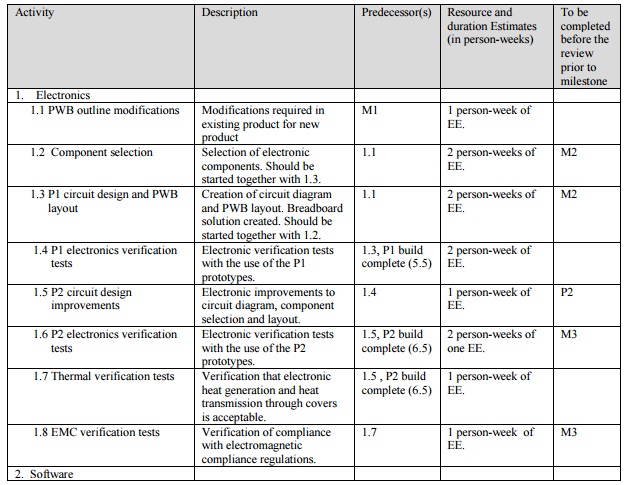
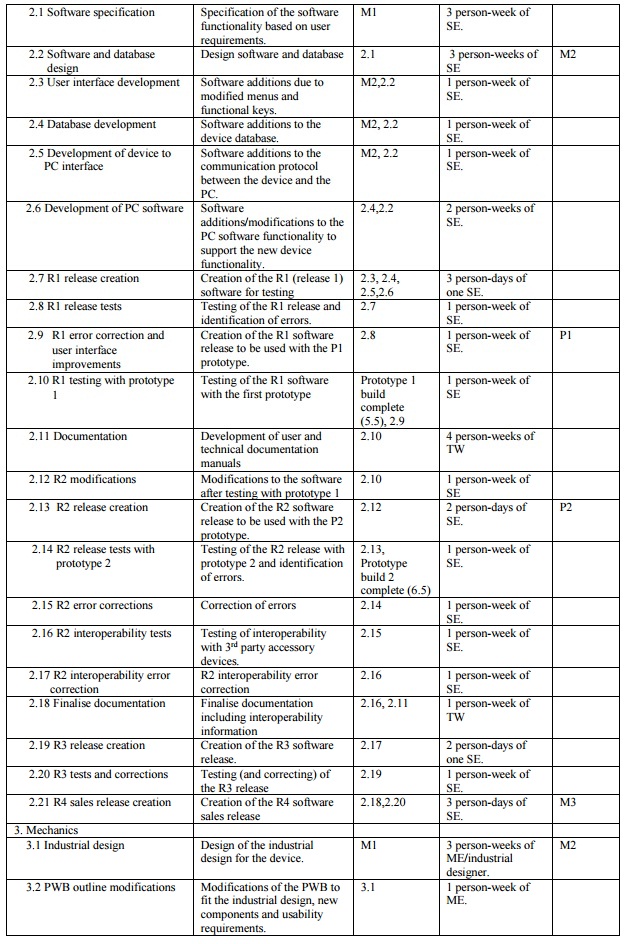
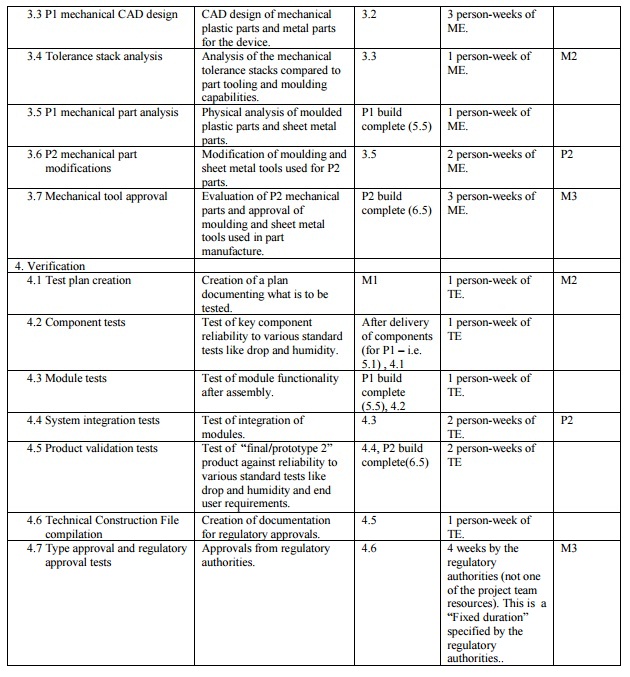
Table: work breakdown structure
Notes:
1. One “person-week” is a “unit of work” representing the work done by one person in one week. It means that the task will normally take one person one week to complete. Note that you can assume that a week refers to a normal working week of 5 days (Mon-Fri) with people working 8 hours per day. This is the default in Microsoft Project. Unless otherwise stated you can also assume a linear relationship, i.e. 3 person-weeks will take one person 3 weeks or 3 people one week. Note that this is not necessarily the case in practice. Refer to the discussion of the “mythical man-month” in your text book (Brooks’ law, chapter 9). In addition, some tasks will be a fixed duration (e.g. delivery times).
2. For the purposes of this assignment (to reduce variability in solutions and complications for the markers) build your Part A1 schedule by assuming that you allocate one resource (i.e. one person with the required skills) to each task. In that case, if the task required 3 person-weeks of an EE you would assign one EE to the task and give it a duration of 3 weeks.
3. Assume that before each milestone is reached, an internal review has been completed and a go/no-go decision has been made. Allow one day for each review to make the “go/no-go” decision after all the “milestone review” predecessors are complete. All the “milestone review predecessors” must be complete before the 1 day for the “go/no-go” review decision.
4. The last column in the table titled “ To be completed before the review prior to milestone” indicates where a task is a predecessor of the one day “milestone go/no-go review”. For example, task 1.2 is one of the predecessors that must be completed before the M2 review. The “M2 review” should take one day and is the predecessor of the M2 milestone (when the milestone is reached it means a decision has been made) . For the purposes of this assignment, you are not required to add resources to these “review” tasks. You can assume the reviews and go/no-go decisions are carried out by management.
5. For the purposes of this assignment, add a “Milestone Reviews” summary task after the last task (which should be “Production of 2000 devices”). The “Milestone Review” should be out-dented at the same level as the Electronics summary task. The “Milestone Reviews” summary task is to be followed by the indented list of “one day milestone reviews” for M2 to M4. The start date of the project followed the M1 concept review.
6. Add a “Milestones” summary task after the reviews. The Milestones summary task should be outdented at the same level as the Electronics summary task. This summary task should have the milestones M1, M2, P1, P2, M3 and M4 indented underneath it. Note that the milestones should be the last items on the “task list” for your schedule.
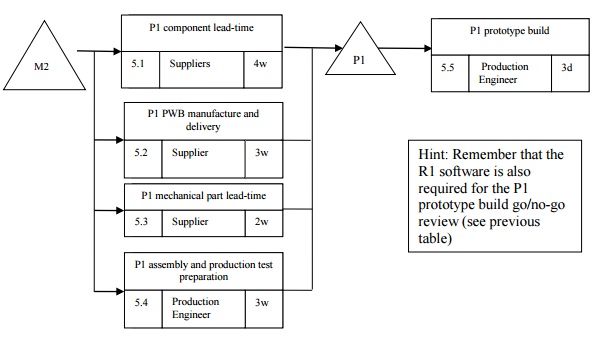
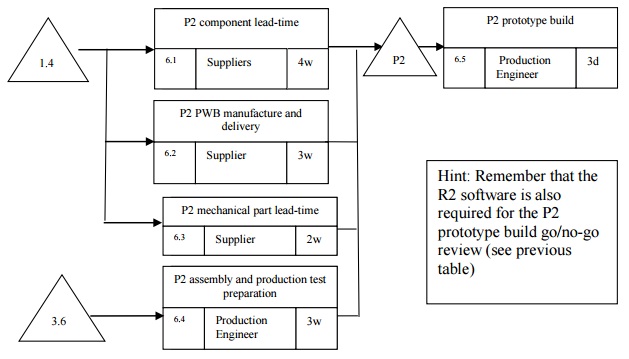
Fig: Activity in Box Network Diagrams for Production
Notes:
1. The resource and duration information on the diagram indicate how long the task will take given one person (with the appropriate skills) assigned to the task. For example, 6.4 will take one Production Engineer 3 weeks to complete. Similarly 6.5 will take one Production Engineer 3 days.
2. Delivery times are “fixed durations”, i.e. additional resources will not impact on the delivery times. Suppliers should not be included as resources in your project. Tasks like 5.1 should not have resources allocated to them in this assignment.
Table 2 - Available Resources
Resource $/hour Number Available
Electronics Engineer $85.00 2
Software Engineer $90.00 2
Mechanical Engineer $95.00 2
Test Engineer $90.00 1
Production Engineer $95.00 1
Technical Writer $80.00 1
The engineers work a 40 hour week from Monday to Friday (i.e. a 5 day week with 8 hour days). The functional managers have assured you that the engineers are able to do all the tasks within their engineering field (e.g. there are no differences between the abilities of the two software engineers).
If the project is resourced as requested your team is committed to producing only two prototype iterations to develop and validate the design
You know that there are items that you may not have sufficient information about yet and that you may need to make some assumptions to complete your schedule and budget. Make sure that you list any assumptions you make at the beginning of your assignment submission.
The rest of details are enclosed below:
Attachment:- project management 2_TERM_1_2016_V9.pdf